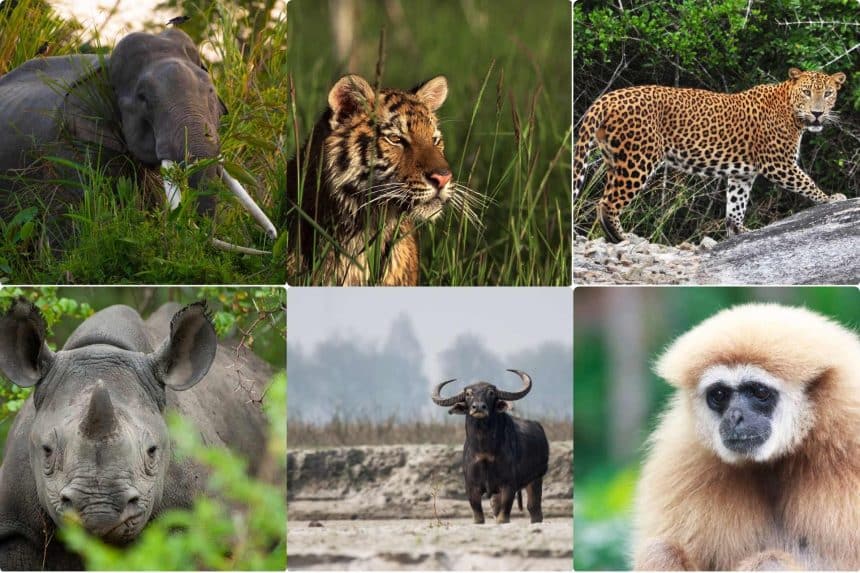Assam, nestled in the northeastern part of India, is a land of unparalleled beauty and rich cultural heritage. While its lush tea gardens and the mighty Brahmaputra River often steal the spotlight, there’s another facet of Assam that captivates adventurers and nature enthusiasts alike – the Big Six.
The Big Six refers to the six iconic wildlife species that are synonymous with Assam’s diverse ecosystems and protected areas. These majestic creatures are not only a source of pride for the state but also play a crucial role in maintaining the ecological balance of the region. Let’s discover these magnificent beings and the habitats they call home.
1. One-Horned Rhinoceros (Rhinoceros unicornis):
Perhaps the most famous among the Big Six, the one-horned rhinoceros is the pride of Assam’s wildlife conservation efforts. Kaziranga National Park, a UNESCO World Heritage Site, is home to the highest population of these prehistoric-looking creatures. With their armor-like skin and a single horn protruding from their snouts, these gentle giants symbolize the resilience of Assam’s wildlife conservation initiatives.
2. Royal Bengal Tiger (Panthera tigris tigris):
The Royal Bengal Tiger, India’s national animal, roams freely in the dense jungles of Assam. Kaziranga, Manas National Park, another UNESCO World Heritage Site, provides a sanctuary for these apex predators. With their striking orange coats and black stripes, these elusive cats epitomize the untamed wilderness of Assam’s protected areas.
3. Asian Elephant (Elephas maximus):
The gentle giants of the forest, Asian elephants, are an integral part of Assam’s cultural and ecological landscape. The Kaziranga-Karbi Anglong landscape serves as a vital corridor for elephant movement, ensuring their survival in the face of habitat fragmentation. From majestic tuskers to playful calves, encountering these magnificent creatures in their natural habitat is a truly unforgettable experience.
4. Hoolock Gibbon (Hoolock hoolock):
Among the smallest and rarest of the ape species, the Hoolock Gibbon is found in the lush rainforests of Assam. The Hoollongapar Gibbon Sanctuary, also known as Gibbon Wildlife Sanctuary, is dedicated to the conservation of these acrobatic primates. With their characteristic whooping calls and agile movements through the forest canopy, Hoolock gibbons add a touch of enchantment to Assam’s biodiversity.
5. Wild Water Buffalo (Bubalus arnee):
Once on the brink of extinction, the wild water buffalo has found refuge in the grasslands and marshes of Assam’s protected areas. Dibru-Saikhowa, Kazirang and other National Park in Assam, a haven for avian and aquatic species, provides a safe haven for these massive herbivores. With their imposing size and formidable horns, wild water buffaloes are a sight to behold in their natural wetland habitats.
6. Clouded Leopard (Neofelis nebulosa):
The mysterious and elusive clouded leopard prowls the dense forests of Assam, blending seamlessly into the dappled sunlight and shadows. Manas National Park, located in the easternmost corner of the state, is one of the few places where these elusive felines can be found. With their mesmerizing spotted coats and nocturnal habits, clouded leopards add an aura of mystique to Assam’s biodiverse landscapes.
The Big Six of Assam are not merely iconic species; they are ambassadors of conservation and symbols of the interconnectedness of all living beings. As stewards of this precious natural heritage, it is our collective responsibility to ensure their protection for future generations to marvel at and cherish. So, if you want to tick off your Big 6 in one travel, hop on to MV Mahabaahu to explore the untamed wilderness of Assam, keep your eyes peeled for these magnificent creatures while on the cruise or off the cruise, for they are the true treasures of the land.
Besides the Big 6 we have more…
With 478 species of birds including the Great Hornbill, Pied Hornbill, Greater Adjutant Stork, Lesser Adjutant Stork, Black Necked Storks, Open Billed Storks, Woolly Necked Storks, Palasus Fishing Eagles, Grey Headed Fishing Eagles, Serpent Eagles, Vultures, Raptors, Kites and many different kinds of ducks, this park is home to many big birds.
Added to all this are the Hillock Gibbons- the only ape of India, Monkeys, Beavers, Squirrels, Monitor and Water Monitor Lizards, Snakes including the King Cobras (hibernating in winters therefore, rarely seen) and Fresh Water Dolphins.
The rolling, lush green elephant grass against the backdrop of the mighty river under the shadows of the towering Himalayan peaks, makes this one of the most beautiful jungles of the world.
Voyaging on-board the M.V. Mahabaahu is equally exciting for luxury, adventure and wildlife enthusiasts alike.
Get ready to spot rare and exotic species from, both, on and off the ship. Some of our guests have been lucky enough to see tigers from the ship itself!
Intrigued enough? Book yourself a spot on the MV Mahabaahu cruise. We sail from October through to April.
Choose from three cruise programs:
- 7 nights Jorhat to Guwahati Assam – a pure wildlife downstream cruise
- 11 nights Guwahati to Jorhat Assam – a mix of culture and wildlife upstream cruise with more of wildlife experience and
- 10 nights Jorhat to Guwahati Assam – a mix of culture and wildlife downstream cruise with more of wildlife experience.

















Leave a Reply
You must be logged in to post a comment.